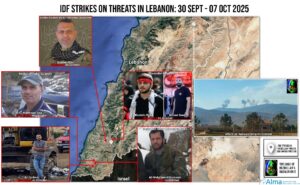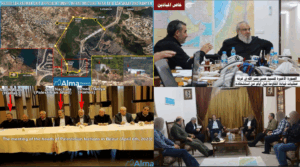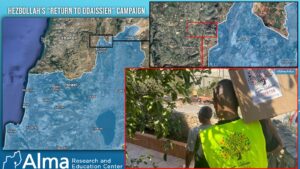During the month of August, Iran conducted a large-scale naval exercise in the Strait of Hormuz, the Gulf of Oman, and the Indian Ocean. The exercise, which lasted two days, included forces from the Iranian army navy, showcasing the launch of cruise missiles, anti-ship missiles (Qadir and Nasir) from both land and sea platforms, as well as the use of UAVs (Ababil type) and electronic warfare systems. Additionally, in one of the videos, a container ship was filmed by a UAV, serving as a threatening message concerning Iran’s capabilities with respect to civilian maritime traffic in the area.
This was the first major exercise Iran held since the war with Israel in June 2025, and against the backdrop of various public reports suggesting the possibility of another round of hostilities between the two states. It appears that the exercise was part of a demonstration of force in light of the war, during which key Iranian military and governmental assets suffered severe damage.
The exercise coincides with statements and threats issued in Iran during and after the war, indicating that Tehran considered closing the Strait of Hormuz, a critical maritime route through which approximately 30% of global seaborne oil trade passes.
As noted in our special report on the IRGC Navy (IRGCN), the Iranian army navy operates alongside, and parallel to, the IRGC navy. Within the division of responsibilities, the army navy operates in the Caspian Sea and the Gulf of Oman (as well as in the Indian Ocean and more distant arenas), while the IRGC navy operates mainly in the Arabian Gulf (or, as the Iranians call it, the “Persian Gulf”) and the Strait of Hormuz.
In recent years, however, it has become evident that the IRGC navy increasingly operates outside the Gulf waters, and cooperation between the two naval branches on various matters has become well-known.
The notion of closing the Strait of Hormuz, thereby obstructing the flow of goods and oil from the Arabian Gulf to the wider world, is not new. This threat has been raised repeatedly in various contexts and functions as one of Iran’s strategic levers of pressure, employed within the framework of its foreign policy (and, as some contend, its domestic policy as well) in pursuit of its objectives.
Iran’s strategic location, the physical characteristics of the Strait of Hormuz and the Arabian Gulf, and the military capabilities it has developed over the years enable it to pose a tangible threat to the freedom of navigation in the region. Moreover, unlike its ballistic arsenal and nuclear project, both naval branches sustained only minor damage during the June war with Israel and are still capable of presenting a certain level of threat.
Iran’s coastline extends over 3,000 kilometers. It is divided between the Arabian Gulf and the Gulf of Oman in the west and south of the country, and the Caspian Sea in the north. The physical characteristics of the Arabian Gulf and the Iranian coastline present significant operational challenges for naval forces operating in the area. The Gulf is about 1,000 kilometers long, its width ranging from 65 to 340 kilometers, with relatively shallow waters averaging 50 meters in depth. The Strait of Hormuz is an even smaller maritime zone, approximately 180 kilometers long and 35–60 kilometers wide. In addition, the coastline of this region is marked by numerous bays, mountainous terrain, and many scattered islands.
Thus, these are confined and shallow maritime zones with relatively short operating distances, subject to coastal control. Added to this is the fact that the waters of the Strait of Hormuz and the Gulf are warm, have relatively high salinity levels, and are characterized by strong currents. These features create operational difficulties for certain types of vessels.
The geographical conditions, along with a series of additional considerations, led Iran to build a significant part of its naval strength in the Strait of Hormuz and the Arabian Gulf as an asymmetric warfare force.
This mode of warfare seeks to challenge superior and larger forces (considered relatively cumbersome) using small, flexible, and fast units while exploiting local terrain conditions. One of the central tactics Iran has developed is the “swarm tactic,” whereby large numbers of fast boats or UAVs are employed simultaneously to breach the defenses of large military fleets. This tactic is intended to create an advantage by employing the element of surprise and overloading the adversary’s defense systems. Other methods adopted by Iran include the use of coastal-defense missiles and naval mines, which provide an advantage in relatively confined and crowded maritime environments such as the Strait of Hormuz and the Arabian Gulf.
Therefore, if Iran will decide to target civilian maritime routes and commercial shipping in the Strait of Hormuz, it has several ways to disrupt freedom of navigation in the area using weapon systems, naval vessels, and special forces.

Deployment of Weapon Systems
One of the simplest and most readily available options for Iran is the deployment of naval mines in the Strait of Hormuz. The use of this measure is relatively simple and inexpensive, does not require risking human lives, allows for a degree of deniability, and can restrict or channel maritime traffic in the area.
Although Iran previously acquired naval mines from China, Russia, and North Korea, today it possesses significant domestic production capabilities. Most of the mines currently in use by Iran are static mines, anchored to the seabed and deployed at varying depths. These are equipped with a range of triggering mechanisms, such as those based on pressure, contact, acoustics, electromagnetic fields, and even optical sensors. Iran also holds more advanced seabed mines that are launched upwards upon activation. Another common type is limpet mines, attached to vessels by combat divers from commando units.
Another category of systems produced in Iran and widely employed by the Houthis is anti-ship missiles. Over time, Iran has developed an extensive arsenal of such missiles with varying ranges, capable of being launched from sea, land, and air platforms. Many of these are indigenized adaptations of Chinese designs, which have been progressively modified, enhanced, and rebranded under different names. This inventory encompasses coastal-defense missiles, cruise missiles, and anti-ship ballistic missiles. Certain models possess ranges of several hundred kilometers and are equipped with diverse guidance and homing systems. Complementing this arsenal is Iran’s ability to deploy explosive UAVs- featuring ranges of several hundred kilometers and warheads weighing tens of kilograms- launched from both maritime and land-based platforms.


Additional Iranian assets include remotely operated weapon systems. These comprise loitering underwater munitions and unmanned suicide vessels. Developed since the 1990s, these systems can carry several hundred kilograms of explosives, have been deployed by the IRGC throughout the Arabian Gulf, and constitute an important element of Iran’s defensive and offensive capabilities. According to various estimates, Iran possesses over 1,000 unmanned vessels of varying sizes and sophistication.

Vessels
As noted, the principal force operating in the Strait of Hormuz is the IRGC navy, which deploys vessels adapted to local conditions. These include fast attack boats, missile boats, submarines, and others. Some of these were purchased from countries such as China, North Korea, and Russia, while others were built domestically- either by duplicating and modifications of existing systems or as original indigenous developments.
One of the central assets used by the IRGC navy is fast attack boats. These vessels, intended to operate under the Iranian swarm tactic, can travel at speeds of 50–70 knots (90–130 km/h) and are equipped with a variety of weapons, including machine guns, rockets, anti-ship missiles, surface-to-air missiles, torpedoes, and the capacity to deploy mines. Their relatively small size, combined with high maneuverability and speed, is designed to improve the survivability of the crews and vessels and to compensate for the lack of defensive systems. Although many are domestically produced, they are based on civilian models converted for military use, often originally manufactured abroad (e.g., in England, Sweden, or North Korea).

In recent years, Iran has employed these boats to seize merchant ships and oil tankers at various points in the Gulf.
Beyond these, Iran has acquired and built patrol and attack vessels, as well as several missile ships. The most advanced among these- such as the “Shahid Soleimani” and “Shahid Abu-Mahdi al-Muhandis” classes- has a range of thousands of kilometers and are heavily armed with cruise missiles, anti-ship missiles, and air-defense systems. They are also equipped with advanced reconnaissance and intelligence-gathering systems above and below water, radar and electronic warfare systems, helicopter landing pads, and the capability of launching fast boats.


These ships can pose a significant threat not only to civilian maritime traffic but also to military vessels operating in or even beyond the Iranian coastal zone. In addition to using live fire, these ships serve as instruments of presence and power projection, providing deterrence and early warning
Alongside the surface fleet, Iran also operates a relatively large submarine fleet, including several models and accompanied by swimmer delivery vehicles (SDVs). Until recently, submarines were operated only by the army navy, but in recent years it appears that the IRGC has also begun deploying submarines.
Apart from three KILO-class submarines purchased from Russia in the 1990s, most of the Iranian submarine fleet consists of small and midget submarines adapted to the conditions and depths of the Arabian Gulf and the Strait of Hormuz. Their primary mission is to conduct tasks related to coastal and territorial water defense, such as patrol, mine deployment, and special forces delivery. Available information suggests, however, that these submarines possess relatively limited endurance, armament capacity, and onboard systems.
In addition to submarines, Iran maintains SDVs for the transportation of combat divers, enabling missions of reconnaissance, intelligence collection, mine deployment, sabotage, and related tasks.

Special Forces
The naval operations of the IRGC, particularly within the Persian Gulf, are frequently characterized by overt and provocative conduct. These actions encompass the harassment of vessels by maritime and aerial platforms, the seizure of oil tankers and commercial ships, their forced diversion to Iranian ports, and the targeting of vessels through the employment of missiles and unmanned aerial vehicles.
At the same time, Iran also conducts low-profile operations. Examples include laying mines in shipping routes, smuggling weapons to various organizations and militias, and executing missions through special forces, mainly for sabotage and intelligence purposes.
Most of the operations requiring physical presence and personnel deployment are carried out by the IRGC naval special forces (S.N.S.F.), also known as the Aba-Abdallah Special Forces Brigade.

This unit, established in 2006, is estimated to number approximately 500–600 personnel, with its main base located on Farur Island, near the Strait of Hormuz. Nevertheless, its personnel are deployed as operational needs dictate throughout the Persian Gulf and beyond.

In this context, it is important to note that Iran views the Gulf islands- primarily Kish, Abu Musa, Siri, and the Tunb islands- as key points in the defense and control of the entire Gulf. Accordingly, the IRGC maintains bases and ports on these islands, from which various units operate.
The unit’s training program extends over a period of roughly two years and is restricted to seasoned combatants with prior service in other IRGC branches. Throughout the course, trainees receive instruction in diving, demolition, marksmanship, reconnaissance, parachuting, maritime raids, helicopter insertion, hostage rescue, vessel seizure, mine laying, naval operations, and the employment of diverse weapon systems.
The unit’s most well-known operation was the 2016 seizure of two U.S. Navy vessels and the capture of their ten crew members.
Its official missions include defending the waters of the Persian Gulf, securing Iranian merchant ships, and executing special missions within the framework of the IRGCN. Another major role of the unit is training militias and organizations belonging to the Shi’a axis, with the unit’s bases also serving as training facilities.
Alongside the Aba-Abdallah unit, two smaller units are active, both charged with securing and defending the Persian Gulf and providing support to other IRGC forces in the region. The first is the Imam Sajjad Commandos Unit, based on Abu Musa Island, whose principal mission is the defense of the numerous islands dispersed throughout the Gulf. The second is the Ansar al-Huja Commando Unit, which fulfills a comparable role.







One Response
Dear Boaz,
Your reporting clearly indicates that the ayatollah regime, the IRGC, and the IRGCN, all remain as serious threats.
It is time to remove the threat.
EVIL must be confronted.
EVIL must be defeated.
God will now turn their threats of “Death to Israel” to be executed upon themselves for their utter destruction.